Companies in a multitude of industries once struggled with whether to offshore manufacturing. Offshoring came at great expense and tremendous risk, but the benefits over time appeared to justify the move – especially when the worker payroll disparity was a major part of manufacturing a specific high-labor product. Fast forward to 2020, and many of those companies are now making the same calculations in the opposite direction as they consider reshoring manufacturing to the United States.
Over the course of the last several decades, companies in all industries expended significant effort offshoring manufacturing of their products to countries with more attractive wages. These countries are generally also relatively loose in their respective regulations, making it easier to manufacture with flexibility and increase profits further. The United States lost nearly 2.5 million manufacturing jobs to China alone in the decade between 2000 and 2010.
Many federal policies also hinder U.S. competitiveness, increasing U.S. manufacturing costs by 20%—even when labor costs are excluded from the calculation:
Things are, however, beginning to change. China is falling out of favor in the public’s opinion in the United States for both political and economical reasons. Recent years have highlighted the issues with the theft of intellectual property, and the Chinese government is suspected of complicity in these efforts.
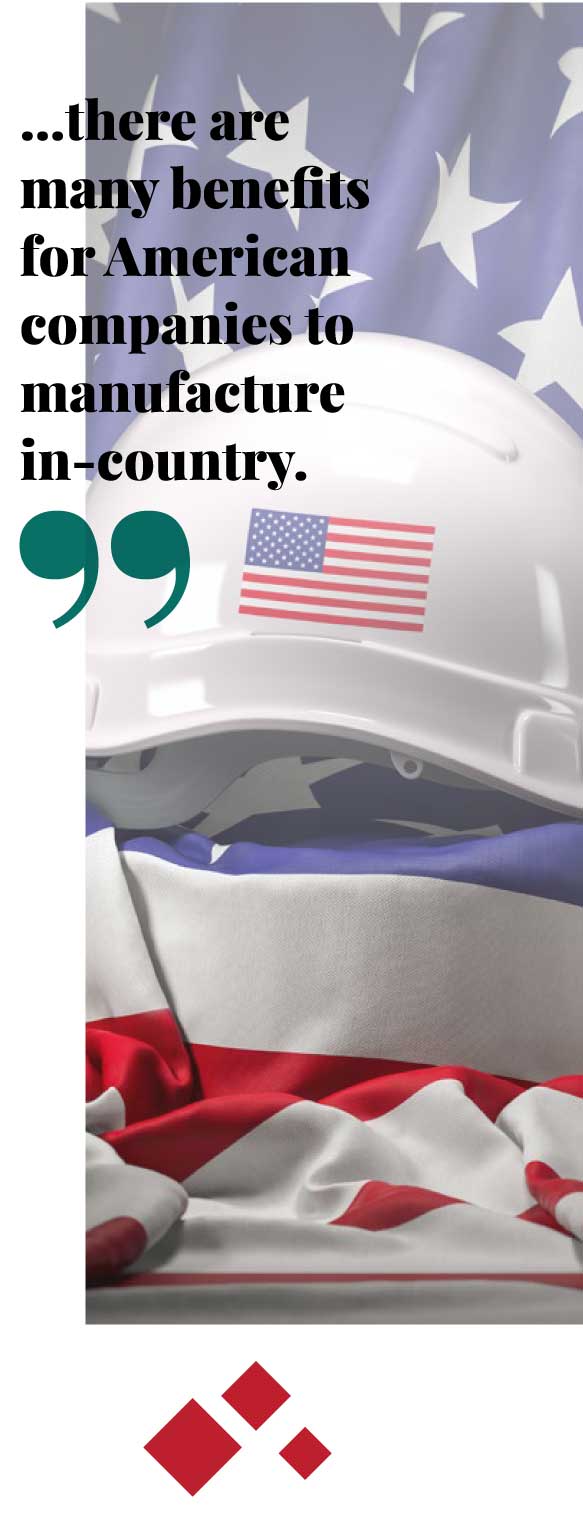
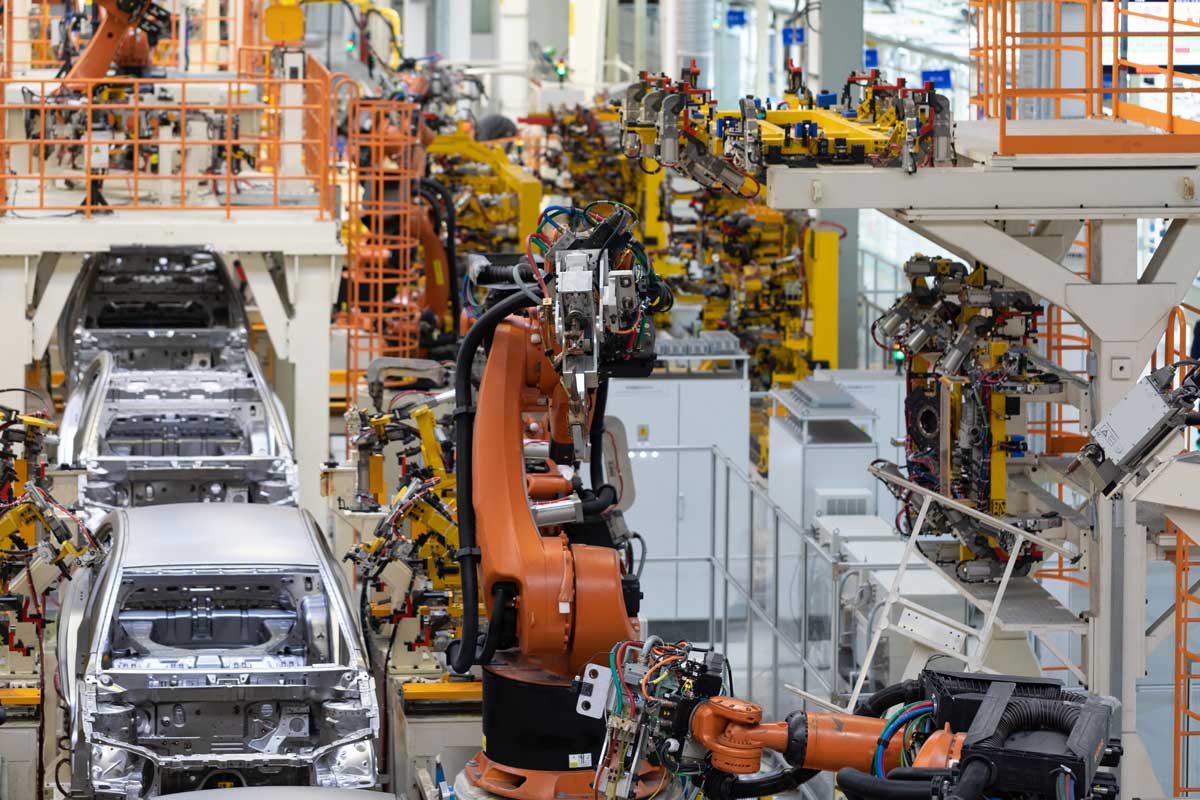
Most recently, the COVID-19 pandemic has caused a further erosion of the public’s opinion of China. The pandemic also highlighted the amount of critical goods that are made in China, including 95% of pharmaceuticals. For many, the handling of the COVID-19 pandemic highlights China’s underlying fragility globally, and it has further eroded trust in the quality of China’s opaque governance. The world also seems to understand that the pandemic is likely far from over, with another surge likely. Many assume these ongoing surges will wreak havoc on supply chains everywhere for many months – or even years – to come.
According to the Wall Street Journal, “amid the U.S.-China trade war, reshoring was already a major issue of discussion before the coronavirus arrived. In its annual assessment of the state of reshoring, consulting firm A.T. Kearney found that American imports of Asian-made goods as a percentage of domestic manufacturing output dropped in 2019, falling from a record high to the lowest level in five years.”(2) The Trump administration is even considering paying U.S.-based companies to bring manufacturing back.(3) In a recent ThomasNet survey, a whopping two-thirds of companies surveyed were “likely to bring production and sourcing back to the continent.”(4) This is a significantly larger percentage than historically reported in the “likely” category.
This tide primarily involves decreased sourcing from China, though some areas considered LCC (Low Cost Countries) are experiencing upticks in manufacturing demand. Many of the trends that China is experiencing, however, are starting to manifest in these other regions as well – and many are experiencing similar trends that are making the lower cost of their labor force less attractive. This leads to many cases in which manufacturing in the United States is more attractive than ever.
And it’s not just America that’s onshoring. The Japanese government has made several indications that they desire Japanese firms to move manufacturing out of China – “especially for products critically important to Japan’s stability and security.”(5) While it may not make sense to manufacture every product in the United States, there are many benefits for American companies to manufacture in-country, many of which have become even more valuable as the world reconsiders globalization.
Quality is a core consideration for most manufacturers, especially those in critical industries such as healthcare, technology, automotive and military hardware. While quality can be challenging regardless of the region in which a product is made, it can be much easier to manage the quality of a supply chain when it is in the same region as a manufacturer. Closer is better when you need to communicate regularly to ensure disparate elements are of the highest quality. High-quality components are a cornerstone of a high-quality assembly. One of the primary drivers of lower costs in less developed areas is less oversight over traditionally regulated manufacturing, and this set of “loose rules” runs counter to maintaining the quality levels required for ongoing market satisfaction. Regions with more mature regulatory systems can create higher quality products as a benefit of that oversight.
One of the biggest risks in offshoring is the supply that is regularly in transit. This product, which is considered complete once in transit, is at a fixed revision. If you discover a problem with a batch upon arrival, you now have a multi-week supply of products that have left the source and not yet arrived at your facility. Those products are all at risk. If there is an undiscovered issue that was not found in manufacturing, you now have a minimum of six weeks of problems – including storing and reworking defective products, lost revenue due to the disruption and managing an influx of customer complaints.
The United States has millions of talented, highly skilled workers. The general work spirit of the American worker is hard to beat; employees at every level are available to conceive, create and develop products that are truly cutting edge. Workers in other countries are smart as well, but the environment that is created by American workers is based on something more. The United States has long been a hotbed of ingenuity combined with a can-do attitude that has built the biggest and longest running economy the world has ever seen.
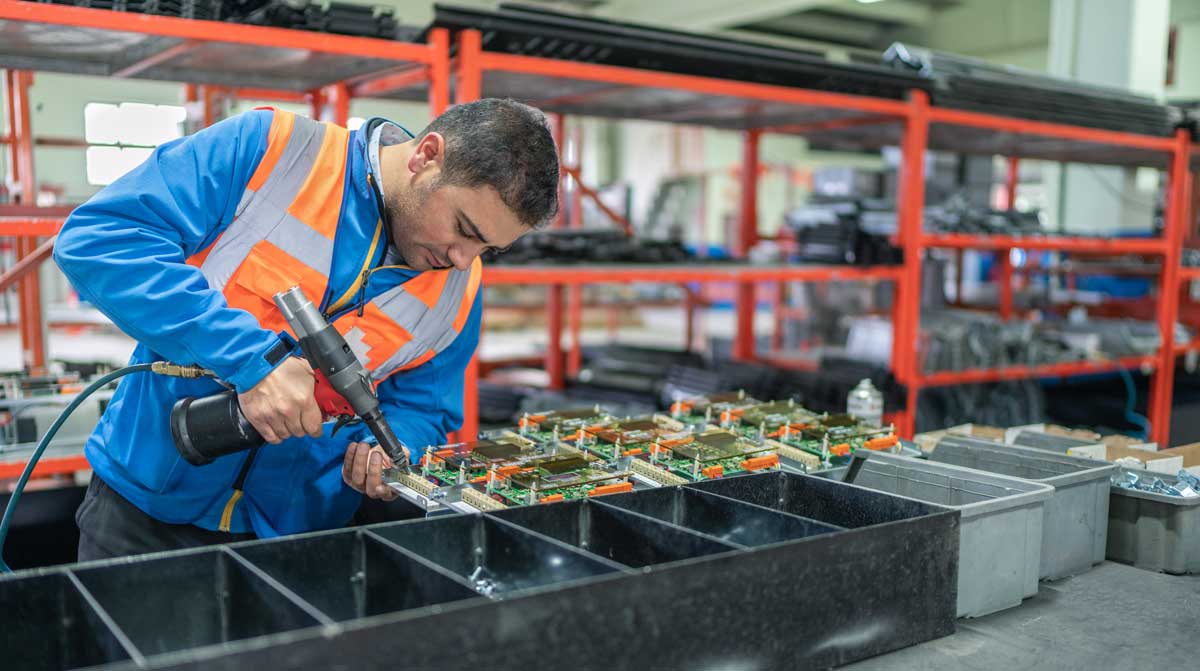
Inbound components that come from nearby suppliers can greatly increase the efficiency of all aspects of component sourcing. There are alignments on the major aspects of supply, including known transport systems, elimination of customs issues, tariffs and, generally, a much shorter delivery time. It’s also beneficial to work with suppliers in a region that have the same overall business philosophies, including quality levels.
An added benefit of domestically managing your supply chain is the clock. It is much more efficient to meet with a team in a time zone an hour or two off than one 12 hours away. This also eliminates many of the language barriers that can exacerbate issues, often creating larger issues from seemingly small miscommunications.
Companies that have locations globally are aware of the challenges with even the most basic communications. When working with an offshore office, there are a variety of discrete costs, risks, and organizational fatigues associated with having a far-flung operational footprint.
Improvements and updates to processes or systems can also be much trickier, since the changes that are desirable company-wide must be implemented at disparate locations by individual teams. This can quickly cause issues if there’s not a concerted effort put into alignment on timing; you cannot have two facilities doing things differently without a risk to overall product quality.
General oversight of a facility is also simplified if it’s easy to visit a different part of a building versus getting on a plane and traveling great distances. There’s a clear cost savings associated with this, as well.

Dependable supplies of resources are available across the United States. According to the U.S. Energy Information Administration (EIA), as of 2019 the U.S. is the world’s largest oil producer. This is a recent development leading to reduced costs for many aspects of manufacturing, the largest of which is transportation and logistics. It also adds important energy independence from other parts of the world where politics and economics are less stable. Natural gas presents a similar scenario: between 2005 and 2014, U.S. production of natural gas liquids (NGLs) increased 70 percent, from 1.74 million barrels per day in 2005 to 2.96 million barrels per day in 2014, and production levels have remained high since.
Because of the greater supply, consumer prices for natural gas are significantly lower in the United States than in Europe and Japan. The low price of natural gas, together with its smaller carbon footprint compared to coal, has encouraged a rapid growth in electricity generated from natural gas in the United States.
Further, the United States has an extremely reliable supply of electricity, water and other natural resources – most of which are found within its own borders. The distribution of energy of all sorts is robust and mature.
While it’s possible that the United States will sign fair trade deals with countries in the coming years, the current uncertainty is causing expensive disruption to global businesses. While the current round of tariffs have settled a bit during the COVID-19 pandemic, this is likely to be an ongoing issue globally for years to come.
Initially, most businesses were willing to simply absorb the tariff costs, but this is sure to be untenable in the longer term. These charges will eventually need to be passed to the end customer, and that will result in lost market share for many product-based companies.

While nobody will tell you that the U.S. business laws are simple, managing multiple legal systems is exponentially more difficult. Even certification for countries outside of the United States are generally easiest to obtain using U.S.-based labs. It’s also true that, while complex, the legal system is extremely beneficial for long-term stability in all areas of a business.
Intellectual property is not protected globally the same way it is in the United States. While there’s no perfect system for protecting your unique and expensive design work, the protections found in the United States and Europe are far superior to those found in many other parts of the world. Some countries seem to encourage – or at least ignore – the theft of intellectual property. Having legal recourse when your IP is stolen at least offers options.
Certain global certifications – like CCC (China Compulsory Certificate) mark in China – require samples of production units for dismantle and analysis to earn the mark. These certification processes introduce an increased level of risk for IP theft.
Innovation goes hand-in-hand with manufacturing. Having U.S. citizens engaged in the process of making things means that there will inherently be inventions that come about during this process.
There is currently a resurgence of the trades – things that may or may not require a college degree. This also bodes well for the future of manufacturing and the availability of a stable long-term workforce, which is critical to the continued growth of manufacturing in the United States.
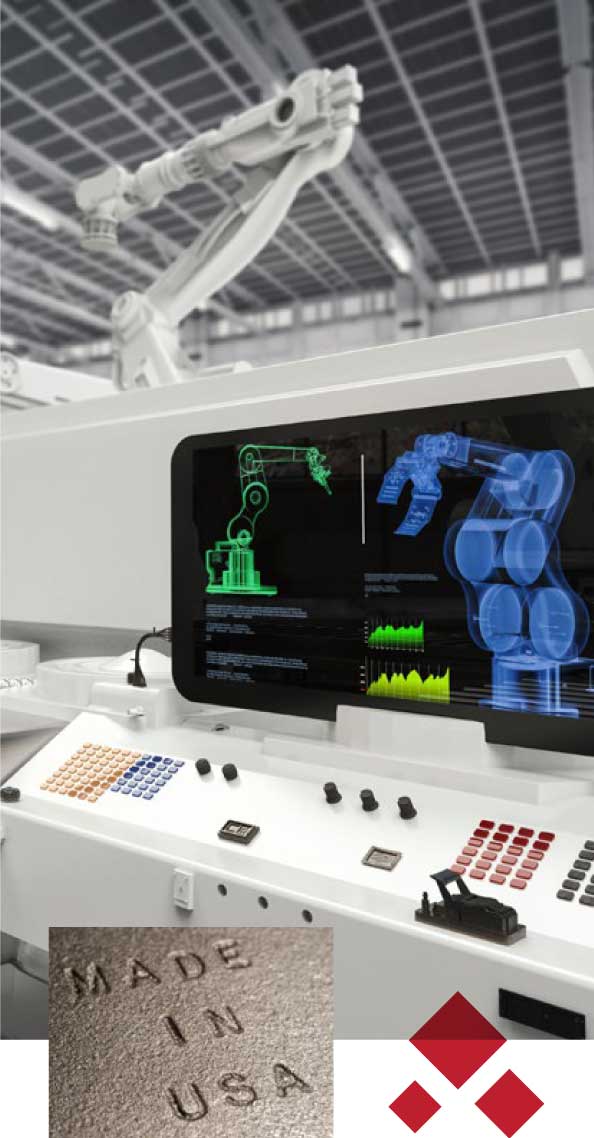
While this is not necessarily part of the fiduciary discussions, it is an important benefit of bringing manufacturing jobs back to the United States. This also carries additional benefits, as there’s a large group of Americans that consider it an important part of the products they prefer. There are also many buying agencies within the government, and many of those have requirements for purchasing products made in the United States.
Returning manufacturing to the United States will also help offset the loss of millions of jobs as a result of the stay-at-home orders across the country. A good number of those will return once things resume, but there should be no doubt that not all will. A larger percentage of employed Americans results in benefits across all segments and industries; we all do better when more of us are working and participating in the economy in a meaningful way.
According to the Wall Street Journal assessment, “It would be inefficient for wealthy countries to attempt to resume much low-value production currently done abroad. Even in high-value sectors, a lack of knowledge, experience and competitiveness in niche areas would prove difficult to surmount.”(2)
It is also clear from recent examples that significant fanfare and positive publicity around reshoring manufacturing can come as a result of bringing jobs home from low-cost regions.

The overall outlook for manufacturing returning to the United States is more positive today than it has been for an exceptionally long time. The elements that once made lower cost wages irresistible have equalized, and public sentiment indicates a willingness to pay more for goods made at home. Time will tell where these sentiments lead corporations, but early indications are clear: there is a renewed interest in reshoring for many reasons.
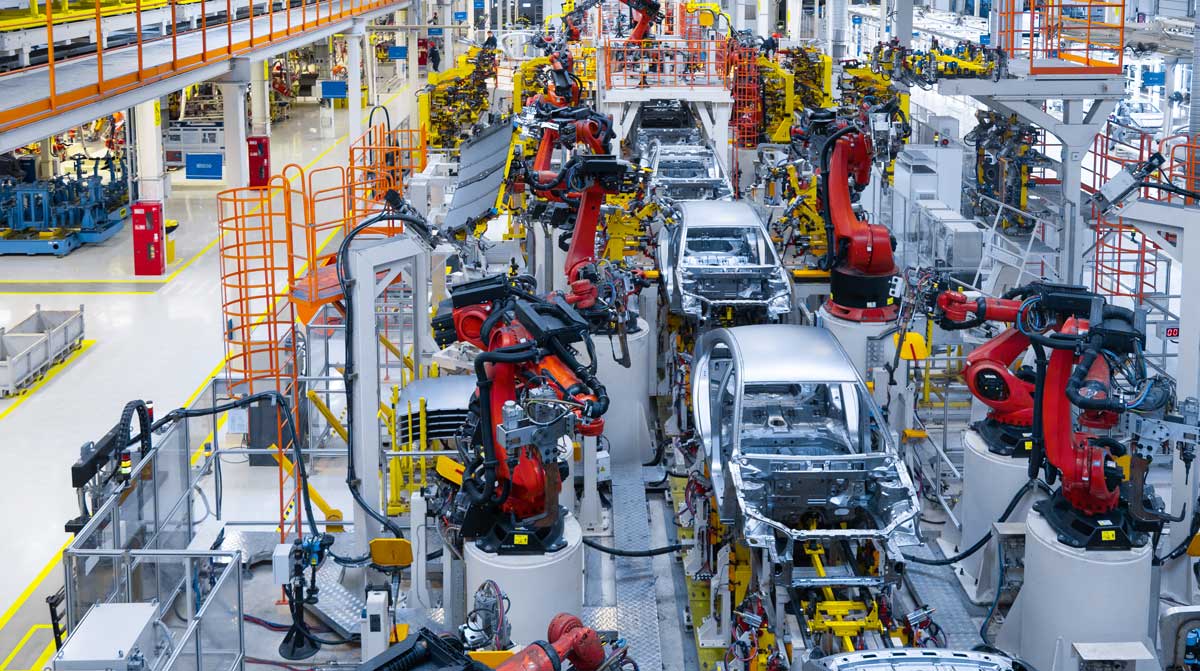
With ISO 13485 and CCC-certified facilities in the USA and Asia, GMI is a premier contract manufacturer of turnkey electro-mechanical solutions and embedded computers for OEMs exclusively. With expertise in DFM, complex mechanical assemblies, industrial computers & complete solutions, GMI is trusted by many global healthcare OEMs, including Philips, Samsung, Elekta, Stryker, Beckman Coulter, GE and many more.
GMI has been assisting OEMs with transferring of high complexity assemblies to U.S.-based manufacturing for decades, and offers options involving its Shanghai, China facility to make the move seamless.
SOURCES
1 The Balance “US Manufacturing Statistics and Outlook”, October 2019
2 Wall Street Journal “Globalized Commerce Might Prove Resilient to the Pandemic”, April 2020
3 Reuters “U.S. mulls paying companies, tax breaks to pull supply chains from China”, May 2020
4 ThomasNet “Push For Supply Chain Resilience, Reshoring Likely To Boost Industrial CRE”, May 2020
5 The Japan Times “Japan prods firms to leave China, affecting ties with Beijing and Washington”, May 2020
GMI Solutions America
10202 North Enterprise Drive
Mequon, WI 53092 USA
(262) 242-8800, option 2
contact@gmisolutions.com
2025 © GMI Solutions. All Rights Reserved. | Terms of Use | Privacy Policy